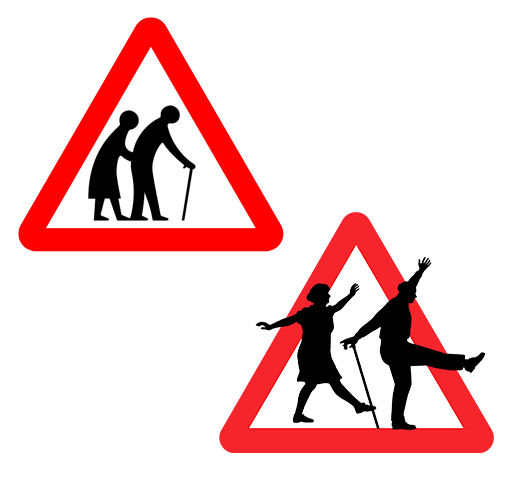1.1.2 Imagery
Like language, images influence how we think, feel and react to what we see. Images that portray older people as frail, vulnerable, in ill health or as victims can also lead to stereotyping behaviour and ignore the diversity of older people.
An everyday example of this is the UK traffic sign warning that older pedestrians may be crossing the road. It was originally designed in 1981 as the result of a children's competition. The same sign is also used for disabled pedestrians. Many older people find this sign to be ageist.
In 2020, the Centre for Ageing Better held a competition inviting designers to ‘rethink the symbols and icons commonly used in public to represent older age groups.’ The winning ‘dancing couple’ design was based on the UK traffic sign.

The judges noted that the winning design was able to capture the diversity of older people, portraying an active and social pair while breaking out of the triangular road sign shape (Centre for Ageing Better, 2020).
Activity 3
Look at the four images below. Which images do you think have a negative influence on how we think and feel about older people? Which ones may have a more positive influence? Why?
Hint: Think about the images you would like to see of yourself or of family and friends.
Comment
Image A is a cartoon depicting an older woman with a walking stick (very commonly depicted) but also with a weak posture and old-fashioned clothes that make her appear child-like. This image focuses on making the older woman look frail and vulnerable with a sad or pained expression on her face.
Image B appears natural, with the older person smiling and looking engaged. The image also challenges stereotypical notions that older people do not engage with modern technology.
Image C shows a pair of older-looking hands close up. Images like this are commonly used in news articles about older people. This means we do not see the individual, something that dehumanises older people and can lead to older people being treated as a homogenous group.
Image D is a staged photo but challenges the typical depictions of what older people wear. The person photographed also looks to be happy, confident and energetic, again making you think beyond typical assumptions.
If your work involves using imagery, the Centre for Ageing Better has created a library of free images to help show a more realistic and diverse depiction of ageing.
Explore the Age-positive image library [Tip: hold Ctrl and click a link to open it in a new tab. (Hide tip)] .
Age Cymru has also developed a free stock image library, providing images that represent the diversity and experience of older people in Wales.
Explore the This is Older stock image library.
Both links will also be available in the resources section at the end of the course.

